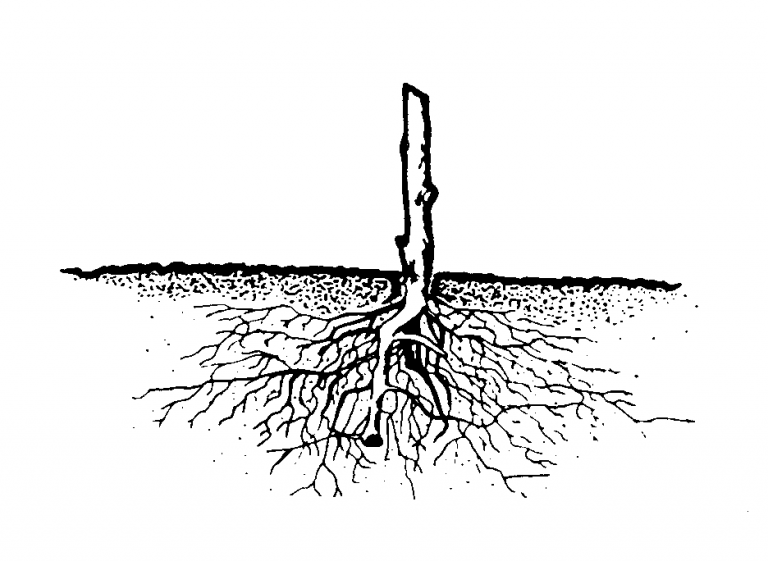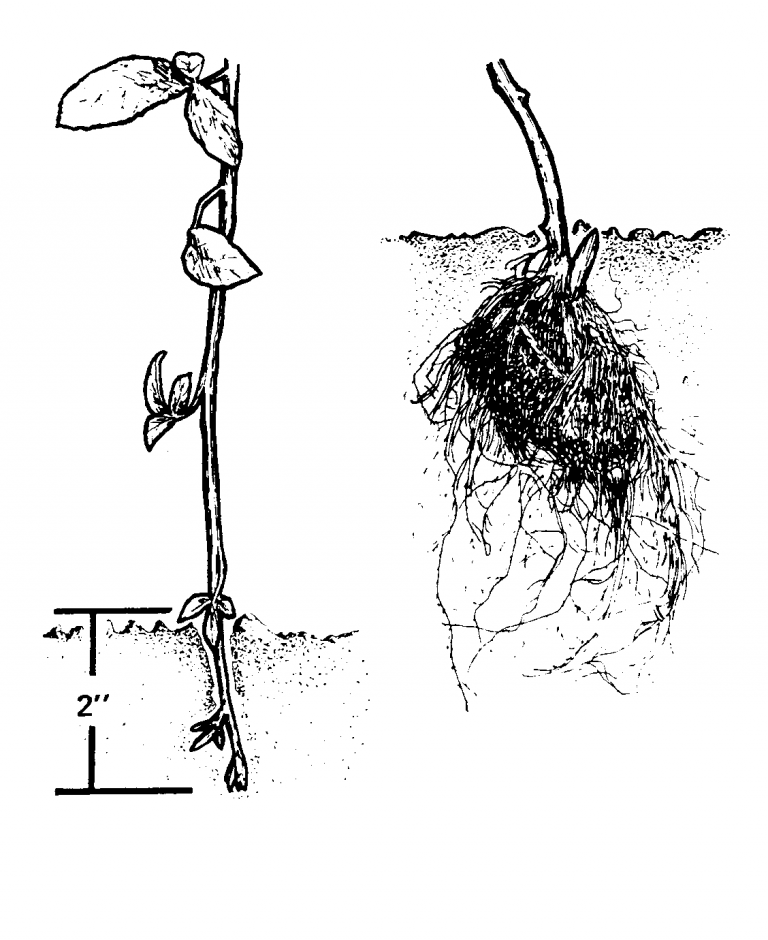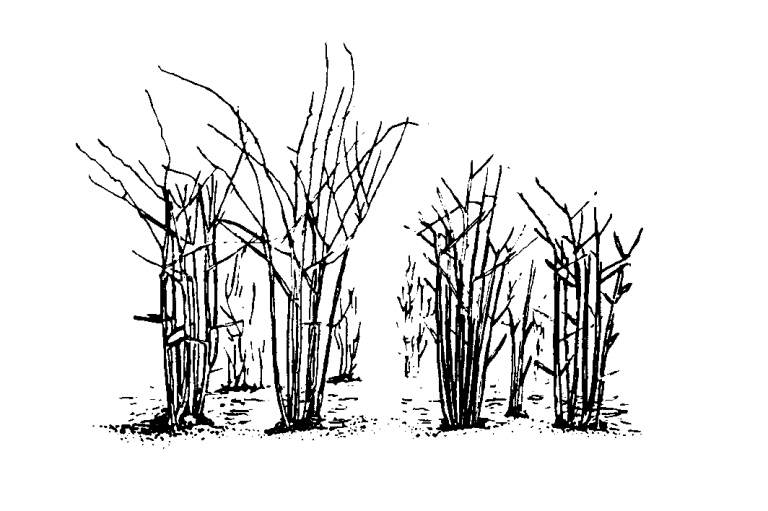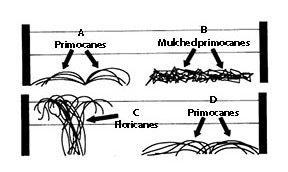Blackberry and Raspberry Culture for the Home Garden
Blackberries are among the easiest of all fruits to grow. Few fruits produce more dependably than blackberries. Properly maintained, irrigated plantings of good varieties may produce crops for 15 years or more. Blackberry fruit has a range of distinctive flavors which vary from sweet to tart. The fruit can be used fresh, frozen or canned. Well established plants will produce about 1 quart or more of fruit per linear foot of row. All these features make blackberries an attractive crop for home gardeners.
Before deciding to grow blackberries, several points should be considered:
- site selection
- variety choice
- site preparation
- propagation & planting
- general care, including mulching, fertilizing, pruning, irrigation, training, and pest control
- harvesting
Site
Cultivated blackberries do best on sandy loam soils with added organic matter. However, they will tolerate a wider range of soil types than most other fruits. Good soil drainage and 2 1/2 feet to 3 feet of unrestricted rooting area is necessary for best plant performance. A site with a slight, north-facing slope is preferred to help prevent spring frost injury and to protect plants from southwest winds in summer. Additional wind protection may be necessary, because succulent first-year canes exposed to strong winds may be blown over and broken from the root system.
Variety Choice
Blackberries and their hybrids have either an erect, semi-erect or trailing growth habit. Semi-erect and trailing blackberries require trellises. Erect blackberries are recommended because they require less labor and materials for trellising. Selection of several varieties can extend the harvest season considerably.
Many good varieties of erect blackberries have been released by researchers in Arkansas. These seem well adapted to Oklahoma conditions. They include:
Arapaho is an erect, thornless blackberry. The fruit are medium sized, firm and have excellent flavor. It begins ripening the first week of June (Tulsa), almost two weeks before Navaho.
Apache is an erect thornless blackberry and is high yielding with large fruit. It has a late harvest season (3rd week of June to first week of August, in Tulsa) and a chill requirement of 800 hours to 900 hours. It has a longer storage potential than most blackberries and is resistant to orange rust, double blossom and anthracnose.
Natchez is a semi-erect thornless blackberry. The large fruit is attached to long pedicels for easy picking and does well on vertical arm trellis and other trellis systems due to its cane flexibility. It is early ripening, like Arapaho, and has a chill requirement of 400 hours to 500 hours. It has suffered some winter damage at -10 F in Oklahoma.
Navaho is an erect, thornless blackberry. The fruit are large, firm and sweet. They ripen late in the season beginning in mid- to late June. It is moderately resistant to anthracnose, and is known hardy to -14 F in Arkansas. Navaho is susceptible to orange rust and double blossom. Due to its excellent flavor and storage it is still grown.
Ouachita is an erect, thornless blackberry with an average size berry with excellent storage. It begins ripening the second week in June (Tulsa) and has a chill requirement of 400 hours to 500 hours. The firm berries allow for longer storage potential than most blackberries and is resistant to orange rust, double blossom and anthracnose.
Osage is an erect thornless blackberry. It has good flavor, texture, aroma and a high yield. It ripens mid-early, slightly before Ouachita and just after Natchez begins harvest. Berries are medium-sized like Ouachita. It stores well and can be shipped commercially.
Some of the thorned floricane that grow well in Oklahoma are: Cherokee, Cheyenne, Chickasaw, Choctaw, and Shawnee. In the past, thorned varieties were regarded as having the biggest sweetest fruit, but through traditional plant-breeding efforts, the thornless ones are now highly comparable. One reason thorned blackberries tasted better was they were allowed to hang a bit longer before someone picked them among the thorns.
Primocane Fruiting Plants
Most blackberries produce fruit on canes produced the previous year (floricanes). Primocane-fruiting blackberries produce fruit on the current year cane. They flower and fruit until the top of the fruiting cane gets killed by cold in the fall and then the remaining part of the cane overwinters (now called a floricane), which flowers and fruits again the following spring. Prime-Jim, Prime-Jan, Prime Ark-45, and Prime Ark Freedom are primocane fruiting varieties. Freedom is thornless.
Raspberries
Raspberries are grown in many of the northern states, but are not generally recommended for Oklahoma as fruit quality and yield is generally poor due to spring freezes and lack of heat tolerance. Buds often break during warm periods in January and February, setting the plants up for freeze damage. Using a 50% shade cloth or planting next to a building or tree line to block the afternoon and evening sun will help reduce heat stress. There are both primocane and floricane fruiting types of raspberry. Their culture is similar to trellised blackberries.
Raspberries come in three main colors – red, black and yellow. Purple varieties are a cross between red and black. As in blackberry, there are primocane and floricane fruiting varieties. There are fall and summer fruiting varieties. Raspberries can also be erect, semi-erect or trailing. Some of the best varieties to try experimentally in Oklahoma are Anne, Autumn Bliss, Boyne, Caroline, Cumberland, Dorman Red, Fall Gold, Heritage, Jaclyn, Jewel, Joan J, Josephine, Magana, Nantahala, Nova and Polka.
Hybrids
There are several blackberry-raspberry hybrids on the market. The hybrids have trailing habits and must be trellised. In order to prevent excessive winter injury, avoid placing canes up on the trellis until late winter or early spring. These hybrids include:
Boysenberry—the berries are large, strongly flavored, soft, and medium to late maturing. When disease free plants are used, Boysenberries may produce well for 4 to 6 years. One selection is thornless and the other has very small thorns.
Dewberry—dewberries ripen early in the season, just ahead of several of the true blackberries. The berries are medium-large, medium-firm and of good flavor. Plants are moderately vigorous and productive. Dewberries are somewhat more winter hardy than Boysenberries.
Youngberry—the berries are dark wine colored, large, sweet, and soft when ripe. They are not as flavorful as Boysenberries. The plants have small thorns, and are vigorous and moderately productive. Youngberries ripen somewhat earlier than Boysenberries.
Bababerry—this is a red raspberry that is said to be heat tolerant. However, this plant has not been very successful in Oklahoma. It is not recommended for planting here.
Site Preparation
A soil test is needed to determine the need for fertilizer and pH adjustment each year. The soil should be deeply cultivated, and organic matter such as compost should be incorporated into the rows. If the soil needs additional drainage, the row areas should be built up into raised beds. The beds should be from 6 inches to 10 inches high and 2 feet to 3 feet wide. Little or no fertilizer is needed the first year. The soil pH should be 6.0 to 6.8. Add lime or sulfur as needed to adjust the pH into the optimum range.
Propagation and Planting
If the blackberries are listed as patented varieties, they may not be legally propagated for sale or for your own use. Non-patented blackberries may be propagated freely. Ask your plant supplier if you are in doubt.
Erect growing varieties are usually propagated with suckers or root cuttings, while the trailing varieties are propagated by means of tip layers. With blackberry viruses on the rise tissue cultured plants are often the best way to buy plants. This insures clean plants. Both the time of propagation and the time of planting are influenced by the habit of growth.
Erect Blackberries—many nurseries produce plants from root cuttings. The root cuttings, 2 to 3 inches long and 1/8 inch diameter or larger, are planted in the early spring (March). The rows of cuttings should be from 1/2 to 1 inch deep, with cuttings 3 to 6 inches apart in the row. Plants will be ready for transplanting into the permanent row during the following winter.
Another method for increasing erect blackberries is from naturally occurring sucker plants. One year old suckers are dug from established rows and set into new permanent rows (Figure 1). More sucker plants can be produced by tilling near existing plants, which breaks the roots and results in generation of new plants from these “cuttings.”
Planting may be done at any time during the dormant season, but most planting is done during February or early March. Space plants 3 feet to 4 feet apart in rows that are 6 feet to 8 feet apart. Plants should be set at the same depth at which they grew in the nursery row. Water the newly set plants.
Trailing blackberries and semi-erect blackberries do not usually produce suckers or develop from root cuttings. An easy, successful method of propagation is by means of tip layers (Figure 2). To tip-layer blackberries, place the tip end of the cane into the soil about 2 inches deep and cover it with soil. This should be done in September or October. Roots will develop during the late fall and winter. Dig the rooted tips during February or early March. Cut the tips from the original canes, leaving a 3- or 4-inch section of the cane attached to it. One established plant may produce from 10 to 20 tip-layered plants each year. The small amount of the cane cut off with the newly rooted layer will not noticeably affect the yield of the remaining cane. Space the new plants the same as erect blackberries.

Figure 1. One year old plant.

Figure 2. Tip layering. Sept – Oct (Left), Feb.-Mar. (Right)
General Care
The crowns and root systems of blackberries live for many years. However, new canes (primocanes) arise from the crown each year and live for only two years. During the first year, the canes grow to their full height. The second season, these canes (floricanes) bear fruit and die. During their first growing season after planting, erect blackberry plants often produce prostrate to semi-erect canes. Erect canes will be produced in the following years.
Mulching. Blackberries should be permanently mulched with about 4 inches of organic material such as pine bark, rice hulls or wheat straw. This mulch will help control weeds, conserve soil and moisture, and prevent winter injury to crowns. Mulching also promotes growth of the extensive fibrous blackberry root system. Since the need to cultivate for weed control is reduced by the mulch, fewer blackberry roots are broken, producing fewer unwanted sucker plants between the rows.
Mulch should be replenished each fall after the first killing frost. Blackberry-raspberry hybrids and raspberries are not usu-ally as winter hardy as blackberries, and may need extra winter mulch to protect the flowering canes. Trailing blackberry varieties and erect varieties in their first year of growth may also be protected in this way. Allow the canes to remain on the ground, and cover them with some grass or straw mulch 4 inches to 6 inches deep. Let this temporary mulch remain until buds on the canes begin growth in late winter or early spring. Then remove it and put the canes on a trellis, if needed, as described below.
Fertilizing. Apply fertilizer to the blackberry plants at bloom to stimulate plant growth, increase berry size and boost total production. A second application of fertilizer should be made following fruit harvest to stimulate vigorous cane growth for next season’s production. Apply fertilizer according to the Table 1.
Table 1. Fertilizer application rates based on nitrogen sources.
| Application | Actual Nitrogen Required | Ammonium Sulfate 21% N | Sulfur-Coated Urea 36% N | Urea 46% N | Blood Meal 12% N | Cottonseed Meal 7% N | Ammonium Nitrate2 34% N |
|---|---|---|---|---|---|---|---|
| 1st Application | 0.4 oz/plant | 2 oz/plant | 1 oz/plant | 0.9 oz/plant | 3.3 oz/plant | 5.7 oz/plant | 1.2 oz/plant |
| 2nd Application | 0.4 oz/plant | 2 oz/plant | 1 oz/plant | 0.9 oz/plant | 3.3 oz/plant | 5.7 oz/plant |
1.2 oz/plant
|
1 Formulations of cottonseed meal vary; nitrogen content is typically around 7%.
2 Regulation of ammonium nitrate is making this fertilizer harder to find.
Pruning. First-year plants are encouraged to fill in their growing space by tipping the primocanes to encourage plant growth. Established plants grow new canes while the old canes are fruiting. During the summer, tip the new canes (primocanes), leaving them 42 inches tall (for free standing plants) or at 10 inches above the top of your trellis wire. Tipping removes the apical dominance allowing the cane to develop lateral shoots. Fruit produced the following year from pruned canes will be at a convenient height for harvest. The fruits will be larger, cleaner and of better quality than if canes are not pruned.
Prune out the gray-looking floricanes in the fall. The primocanes are a green to burgundy color. Make the pruning cuts near the crown of the plant, and remove the old canes from the field to decrease insect and disease problems in the future.
New canes that have produced lateral branches after summer pruning should be pruned again in late winter (February or early March) to simplify harvesting and increase berry size. Shorten lateral branches to about 12 inches in length. Some new canes will need to be removed during the winter so fruit harvest will be easier the next year. This thinning will also increase air circulation, discouraging disease growth. Remove any canes that have red-necked cane borer swellings and destroy to reduce populations. Leave 3 canes to 5 canes per linear foot of row on erect blackberries (Figure 3). Leave 8 canes to 15 canes of 4 feet to 8 feet in length on trailing varieties which are to be trellised. If not trellising them, reduce to 3 canes to 5 canes. If there are dead canes which fruited but were not removed during the previous summer, these should be removed at this time.
Trailing blackberries and semi-erect blackberries need a trellis for support. The trellis may be shaped like an “F” (Figure 4) or “T” (Figure 5). Additional, lower wires and crossbars may be added to the “T” to make a “V” trellis, which is easier to train the growing canes onto. The moveable arm trellis system also works well with varieties such as ‘Natchez.’
The “F” trellis is especially useful in northern Oklahoma, because it allows the primocanes, or current season’s growth, which has not yet flowered, to be mulched during the winter. This mulch can help prevent early budbreak and winter injury to buds. Floating row covers also can be used to protect the primocanes that are laying over. During the winter, the primocanes become floricanes, or flowering canes.
When growth starts in the spring, these canes must be placed up on the trellis and tied loosely with natural fiber twine or with tape, which is especially made for the purpose. New primocanes will develop at the base of the plant while the floricanes are flowering and setting fruit. These primocanes will be a nuisance when picking the fruit, but must be treated well to produce a good crop next year. The “T” and “V” trellises allow training of floricanes to one side of the trellis, and primocanes to the other side of the trellis. This makes picking and pruning much easier than having all the canes mixed together. It also gets the primocanes up out of the way. Primocane training must be repeated every 2 weeks throughout the growing season in order to keep the canes under control.

Figure 3. Pruning erect canes. Before (left), After (right)

Figure 4. F-trellis. A – Primocanes grow during the spring and summer, and are left on the ground under the trellis. B – Mulch can be put over the primocanes in winter to help protect against cold injury. C – After growth begins in the spring, the mulch should be taken off the canes. The canes which have changed to floricanes during the winter should be tied loosely to the trellis wires. D – After the fruit are picked, the floricanes should be removed, leaving the new primocanes under the trellis.

Figure 5. T-trellis. All new growth is trained to one side of the trellis, leaving the floricanes on the other side of the trellis, where they were placed the year before.
Irrigation. Immediately after planting, water thoroughly. One inch to two inches of water per week (rainfall and/or irrigation) is needed for good plant growth and quality fruit to occur. Drought severely decreases production and berry quality, however, excess watering can cause the roots of the blackberries to die.
Pest control
Spraying/or excluding pests for insect, disease, and weed control (Extension Current Report CR-6243) is necessary. In blackberries, liquid lime-sulfur is applied at 1/16” budbreak for anthracnose control. An appropriate pesticide should be applied at bloom time to control strawberry clipper. Plants may need to be sprayed during harvest to control the newly introduced Spotted Winged Drosophila. Raspberry Cane and Crown Borer’s are other major insect pests. For current pesticide recommendations, contact the local county Extension office.
It is best to eliminate weeds before planting. After planting, kill weeds by spraying, or exclude them by blocking out the sun with mulch. The Midwest Small Fruit Spray Guide is a very useful resource for pest control information
Harvesting
Since the excellent flavor of blackberries is associated with full maturity, they should be picked at the correct stage of development. As blackberry fruit mature, they enlarge, develop a deeper blue-black color and soften. When the berries appear ripe, a “taste test” is the best indicator of when to pick.
Harvest fruit during the cooler part of the day and plan to refrigerate the berries soon after harvest. These berries will usu-ally remain in good condition for several days.
Berries exposed to high temperatures after picking often decay rapidly.
Additional Published Material
BAE-1511 Drip Irrigation Systems
PSS-2207 How to Get a Good Soil Sample
PSS-2750 Guide to Effective Weed Control
HLA-6005 Mulching Garden Soils
HLA-6007 Improving Garden Soil Fertility
CR-6221 Commercial Blackberry, Strawberry and Blueberry Insect and Disease Control
HLA-6222 Home Fruit Planting Guide
HLA-6239 Commercial Blackberry Production
CR-6243 Weed Management in Small Fruit Crops
HLA-7450 Safe Use of Pesticides in the Home and Garden
L-220 Plant Disease and Insect Diagnostic Laboratory
Kenda Woodburn
Tulsa County Horticulture Extension Educator
David Hillock
Assistant Extension Specialist, Consumer Horticulture
Becky Carroll
Extension Assistant, Fruit & Pecan
